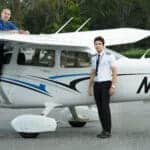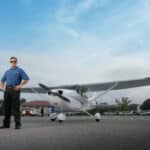Commercial Pilot India: 2025 Ultimate Guide to the DGCA Requirements

Commercial Pilot India is one of the fastest-growing career paths as the country’s aviation industry continues to expand in 2025. With new airlines entering the market and existing carriers scaling operations, the demand for skilled pilots has never been higher.
However, starting a professional flying career begins with meeting the strict standards set by the Directorate General of Civil Aviation (DGCA). From educational qualifications to flight hours and licensing exams, every step must align with DGCA requirements.
This guide offers a complete breakdown of everything future pilots need to know. Whether you are just completing school or planning a career change, understanding the 2025 DGCA rules is essential for anyone pursuing Commercial Pilot India opportunities.
Who is a Commercial Pilot in India?
A Commercial Pilot India holder is a trained professional authorized to operate aircraft for hire and reward. In India, this means flying passengers, transporting cargo, conducting charter flights, offering aerial services, or working in corporate aviation.
To become a commercial pilot, candidates must obtain a Commercial Pilot License (CPL), issued and regulated by the Directorate General of Civil Aviation (DGCA). This license is mandatory for anyone who wants to be paid for flying duties.
After obtaining their CPL, pilots can pursue multiple career paths. Some join domestic or international airlines, others fly private jets, while many take up specialized roles such as cargo transport, flight instruction, or aerial surveying. A commercial pilot’s career can be dynamic, offering opportunities for rapid growth, especially with the rising demand for aviation professionals in India and abroad.
2025 DGCA Eligibility Requirements for Commercial Pilot India
Before starting the journey toward a Commercial Pilot India career, candidates must meet specific eligibility standards set by the Directorate General of Civil Aviation (DGCA). These requirements ensure that every future pilot has the academic background, physical fitness, and communication skills needed for safe flight operations.
To qualify for CPL training in 2025, candidates must fulfill the following basic conditions:
Age Requirement: Candidates must be at least 18 years old at the time of applying for the CPL.
Educational Qualification: Completion of 10+2 education with Physics and Mathematics from a recognized board is mandatory. Students without these subjects can clear them through the National Institute of Open Schooling (NIOS) or an equivalent authority.
Medical Fitness: A DGCA Class 1 Medical Certificate is essential. This involves a thorough evaluation of physical and mental health, eyesight, hearing, and cardiovascular fitness to ensure a candidate is medically fit to operate an aircraft.
English Language Proficiency: Pilots must demonstrate the ability to read, write, and communicate fluently in English. Aviation operations worldwide use English as the standard language for communication, making proficiency a critical safety factor.
Meeting these eligibility criteria is the first step toward enrolling in a DGCA-approved flight training program and working toward a professional flying career.
Step-by-Step Process to Become a Commercial Pilot India
Starting a career as a Commercial Pilot India professional requires following a structured pathway laid out by the DGCA. Every step is essential to ensure pilots are fully qualified and ready to operate aircraft safely and professionally.
Here’s how the process unfolds:
First, candidates must meet the basic eligibility criteria, including age, educational qualifications, and English proficiency. Once these requirements are fulfilled, the next step is clearing both the DGCA Class 2 and Class 1 Medical Examinations, ensuring the candidate is physically and mentally fit for flying duties.
After medical clearance, aspiring pilots must enroll in a DGCA-approved flight school like the Florida Flyers Flight Academy India. Here, students undergo rigorous ground school training, covering core aviation subjects like navigation, meteorology, air regulations, and technical operations.
Following ground school, students begin flight training, during which they must log a minimum of 200 flying hours. These hours include solo flights, cross-country navigation, instrument flying, and night operations.
Once the required flying hours are completed, candidates must pass the DGCA written examinations and successfully complete the skill test and check rides under the supervision of a DGCA-appointed examiner.
Each of these steps brings candidates closer to earning the coveted Commercial Pilot License, opening doors to various aviation career paths across India and abroad.
DGCA Written Exams You Must Clear
To become a licensed Commercial Pilot India professional, candidates must successfully clear a set of theoretical exams conducted by the DGCA. These examinations test the pilot’s knowledge of essential aviation principles and operational procedures.
The key DGCA exams include:
- Air Navigation: Understanding the science of navigation and flight planning.
- Air Meteorology: Studying weather patterns and their effects on flight safety.
- Air Regulations: Learning national and international aviation rules and procedures.
- Technical General and Technical Specific: Covering aircraft systems, performance, and specific aircraft operations.
- RTR (Aero) License: Radio Telephony Restricted (Aero) certification for effective communication with Air Traffic Control (ATC).
Clearing these exams is a critical milestone, ensuring that candidates possess both the theoretical knowledge and practical skills required to operate commercial aircraft under DGCA regulations.
Cost of Becoming a Commercial Pilot India (2025 Estimate)
Pursuing a career as a Commercial Pilot India professional involves a significant financial investment. Understanding the overall cost early helps candidates plan their training journey effectively.
On average, the cost of commercial pilot training in India ranges between ₹35 lakh to ₹50 lakh (approximately USD 42,000 to 60,000), depending on the flight school, aircraft type, and training quality. This estimate typically covers ground school instruction, flying hours, and standard training materials.
In addition to tuition fees, candidates should also budget for additional expenses such as:
- Medical examinations: Charges for DGCA Class 2 and Class 1 medicals
- DGCA examination fees: Application and sitting costs for each theory paper
- Simulator sessions: Advanced flight simulator training modules
- License processing fees: DGCA costs for issuing the CPL
Many students explore scholarship programs and financial assistance options offered by state governments, aviation academies, or private institutions. Carefully evaluating these opportunities can significantly reduce the out-of-pocket expense of earning a Commercial Pilot License.
Planning your finances strategically ensures a smoother, stress-free training experience.
Comprehensive Cost Breakdown
| Expense Category | Estimated Cost (INR) | Details |
|---|---|---|
| Flight Training (200–220 hrs) | ₹35–45 lakhs | Includes aircraft rental, instructor fees, fuel, and other related expenses. |
| Ground School | ₹2–4 lakhs | Covers theoretical instruction in subjects like navigation, meteorology, and regulations. |
| Medical Examinations | ₹5,000–15,000 | DGCA Class 1 and Class 2 medical assessments to ensure fitness for flying. |
| DGCA Examination Fees | ₹20,000–40,000 | Fees for mandatory written and practical examinations. |
| Type Rating (Optional) | ₹15–20 lakhs | Specialized training for specific aircraft models, often required by airlines. |
| Miscellaneous Expenses | ₹1–2 lakhs | Includes uniforms, study materials, accommodation, and other incidental costs. |
| Total Estimated Cost | ₹60–75 lakhs | Aggregate of all expenses for obtaining a CPL in India. |
Note: Costs are approximate and can vary based on individual circumstances and choices.
Best DGCA-Approved Flight Schools in India (2025)
Selecting the right flight school is crucial for aspiring commercial pilots. Below is a curated list of reputable DGCA-approved flying training organizations (FTOs) in India, highlighting their locations, estimated costs, and key features:
Top DGCA-Approved Flying Schools
| Flight School | Location | Estimated CPL Cost (INR) | Key Highlights |
|---|---|---|---|
| Florida Flyers Flight Academy India | Gurgaon, Haryana | ₹45 lakhs | DGCA-approved; integrates FAA standards; offers ground school in India.; modern fleet and simulators. |
| National Flying Training Institute (NFTI) | Gondia, Maharashtra | ₹34.6 lakhs | Joint venture with CAE Inc.; modern facilities; airline tie-ups. |
| Bombay Flying Club | Mumbai, Maharashtra | ₹35–40 lakhs | Established in 1928; offers BSc in Aviation; located at Juhu Aerodrome. |
| Madhya Pradesh Flying Club (MPFC) | Indore, Madhya Pradesh | ₹8.5 lakhs/year | One of the oldest clubs; budget-friendly; operates in Indore and Bhopal. |
| Ahmedabad Aviation & Aeronautics Ltd. (AAA) | Ahmedabad, Gujarat | ₹24.6 lakhs | DGCA-approved; operates Cessna 152 aircraft; budget-friendly option. |
| Chimes Aviation Academy (CAA) | Dhana, Madhya Pradesh | ₹30+ lakhs | Modern training methods; strong industry ties; integrated CPL program. |
| Capt Gopi Aviation Academy | Hyderabad, Telangana | ₹95,000 (Ground School) | Personalized approach; combined RTR + CPL prep; small batch sizes. |
| Indira Gandhi Institute of Aeronautics (IGRUA) | Amethi, Uttar Pradesh | ₹45 lakhs | Government-run; rigorous selection process; modern fleet and simulators. |
| Indira Gandhi Institute of Aviation Technology | New Delhi | ₹60,000 – ₹85,000 | Operated by DGCA; standardized curriculum; suitable for government-sponsored cadets. |
Note: Costs are approximate and may vary based on individual circumstances and additional training requirements.
Factors to Consider When Choosing a Flight School
When selecting a flight school, consider the following:
Cost and Financing: Evaluate the total cost and availability of financial assistance or scholarships.
DGCA Approval: Ensure the institution is recognized by the Directorate General of Civil Aviation.
Fleet and Facilities: Modern aircraft and simulators enhance training quality.
Instructor Expertise: Experienced instructors contribute to better learning outcomes.
Placement Records: Schools with strong industry connections may offer better job opportunities.
FAQs About Commercial Pilot India DGCA Requirements
What is the minimum age for becoming a Commercial Pilot India candidate?
To start training as a Commercial Pilot India aspirant, you must be at least 18 years old by the time you apply for the DGCA-issued license.
How many flying hours are required for the DGCA CPL in India?
The Directorate General of Civil Aviation (DGCA) requires a minimum of 200 flight hours for anyone pursuing the Commercial Pilot India license.
What is the cost of pilot training in India?
Training costs typically range from ₹35 lakh to ₹50 lakh, depending on the academy, aircraft type, and additional services like simulator training or type rating.
Can a commerce student become a commercial pilot India?
Yes. Commerce students can become pilots by completing Physics and Mathematics through the National Institute of Open Schooling (NIOS) or another approved body.
How long does it take to complete commercial pilot training India?
The entire process—from enrollment to CPL issuance—usually takes 18 to 24 months, depending on flight availability, weather, and personal progress.
Contact the Florida Flyers Flight Academy Team today at 91 (0) 1171 816622 to learn more about the Private Pilot Ground School Course.



Table of Contents






